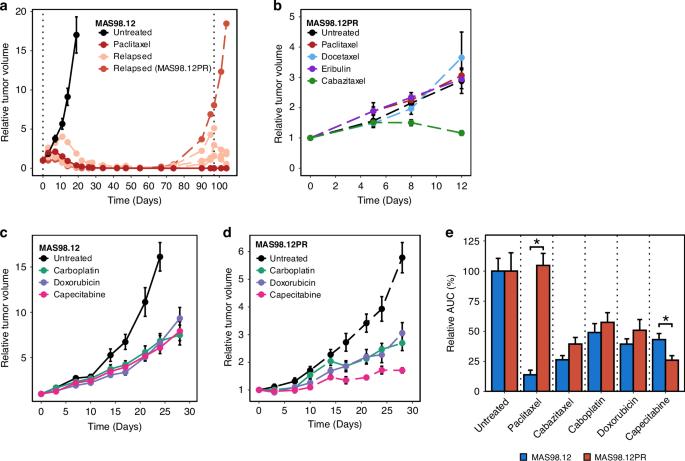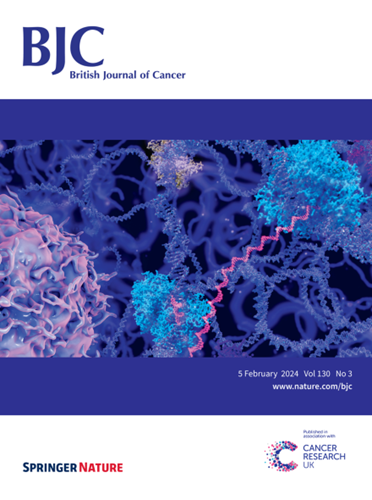The SRC-family serves as a therapeutic target in triple negative breast cancer with acquired resistance to chemotherapy
IF 6.4
1区 医学
Q1 ONCOLOGY
引用次数: 0
Abstract
Resistance to chemotherapy, combined with heterogeneity among resistant tumors, represents a significant challenge in the clinical management of triple negative breast cancer (TNBC). By dissecting molecular pathways associated with treatment resistance, we sought to define patient sub-groups and actionable targets for next-line treatment. Bulk RNA sequencing and reverse phase protein array profiling were performed on isogenic patient-derived xenografts (PDX) representing paclitaxel-sensitive and -resistant tumors. Pathways identified as upregulated in the resistant model were further explored as targets in PDX explants. Their clinical relevance was assessed in two distinct patient cohorts (NeoAva and MET500). Increased activity in signaling pathways involving SRC-family kinases (SFKs)- and MAPK/ERK was found in treatment resistant PDX, with targeted inhibitors being significantly more potent in resistant tumors. Up-regulation of SFKs- and MAPK/ERK-pathways was also detected in a sub-group of chemoresistant patients after neoadjuvant treatment. Furthermore, High SFK expression (of either SRC, FYN and/or YES1) was detected in metastatic lesions of TNBC patients with fast progressing disease (median disease-free interval 27 vs 105 months). Upregulation of SFK-signaling is found in a subset of chemoresistant tumors and is persistent in metastatic lesions. Based on pre-clinical results, these patients may respond favorably to treatment targeting SFKs.

SRC家族是对化疗产生获得性抗药性的三阴性乳腺癌的治疗靶点。
背景:化疗耐药以及耐药肿瘤之间的异质性是三阴性乳腺癌(TNBC)临床治疗中的重大挑战。通过剖析与耐药性相关的分子通路,我们试图确定患者亚群和下一步治疗的可行靶点:方法:对代表紫杉醇敏感和耐药肿瘤的同种异源患者异种移植物(PDX)进行了大量 RNA 测序和反相蛋白质阵列分析。在耐药模型中被确定为上调的通路在 PDX 外植体中作为靶点进行了进一步探索。在两个不同的患者队列(NeoAva 和 MET500)中评估了它们的临床相关性:结果:在治疗耐药的PDX中发现,涉及SRC-家族激酶(SFKs)和MAPK/ERK的信号通路活性增加,靶向抑制剂在耐药肿瘤中的作用明显更强。在新辅助治疗后的化疗耐药患者亚群中也发现了 SFKs 和 MAPK/ERK 通路的上调。此外,在病情进展较快的TNBC患者的转移病灶中(中位无病间隔时间为27个月与105个月)也检测到了SFK的高表达(SRC、FYN和/或YES1):结论:SFK 信号的上调存在于化疗耐药的肿瘤亚群中,并在转移病灶中持续存在。根据临床前研究结果,这些患者可能会对靶向 SFKs 的治疗产生良好反应。
本文章由计算机程序翻译,如有差异,请以英文原文为准。
求助全文
约1分钟内获得全文
求助全文
来源期刊

British Journal of Cancer
医学-肿瘤学
CiteScore
15.10
自引率
1.10%
发文量
383
审稿时长
6 months
期刊介绍:
The British Journal of Cancer is one of the most-cited general cancer journals, publishing significant advances in translational and clinical cancer research.It also publishes high-quality reviews and thought-provoking comment on all aspects of cancer prevention,diagnosis and treatment.
 求助内容:
求助内容: 应助结果提醒方式:
应助结果提醒方式:


